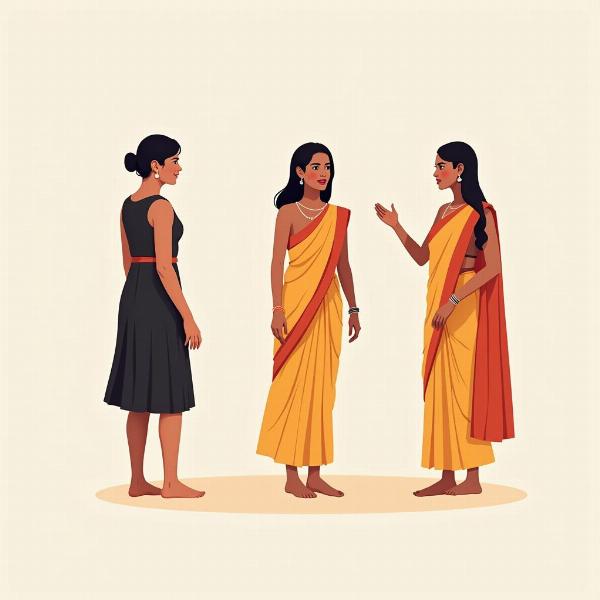Understanding the nuances of “I heard you” in Hindi can be tricky, as a direct translation often doesn’t capture the full meaning. While a literal translation might be “maine tumhe suna,” this phrase isn’t commonly used in everyday conversation and can sound unnatural. The appropriate Hindi phrase depends heavily on the context and the intended meaning you want to convey. Are you simply acknowledging that you heard the words spoken, or are you expressing understanding, agreement, or even dismissal? Let’s delve into the various ways to express “I heard you” in Hindi.
Different Ways to Say “I Heard You” in Hindi
Choosing the right Hindi equivalent for “I heard you” depends on the specific situation. Here are some common options:
- “Maine sun liya” (मैंने सुन लिया): This is perhaps the closest literal translation and signifies that you have heard the words spoken. It’s a neutral acknowledgment and suitable for most situations.
- “Thik hai” (ठीक है): This translates to “okay” and is often used to acknowledge instructions or requests. It implies agreement or compliance.
- “Accha” (अच्छा): Meaning “good” or “okay,” “accha” can convey understanding or acknowledgement. It’s more informal than “thik hai.”
- “Samjha/Samjhi” (समझा/समझी): This translates to “I understand.” Use “samjha” for masculine subjects and “samjhi” for feminine subjects. This goes beyond simply hearing and indicates comprehension of the message.
- “Haan, sun raha/rahi hoon” (हाँ, सुन रहा/रही हूँ): This phrase means “Yes, I’m listening.” Use “raha hoon” for masculine subjects and “rahi hoon” for feminine subjects. This is suitable when someone is explaining something and you want to reassure them that you’re paying attention.
- Just a nod or a simple “Hmm” (हम्म): In informal settings, a simple nod or “hmm” can suffice to acknowledge that you’ve heard.
Understanding the Context
The cultural context plays a significant role in choosing the correct phrase. Indian communication often emphasizes politeness and respect, so using the right tone and phrasing is crucial. For instance, using “thik hai” with an elder might be considered disrespectful if said curtly. Instead, a more respectful phrase like “ji, maine sun liya” (जी, मैंने सुन लिया) would be more appropriate.
Common Scenarios and Examples
Let’s look at some examples to illustrate how these phrases are used in everyday conversations:
-
Scenario: Your friend tells you about their day.
- Response: “Accha” or “Maine sun liya.”
-
Scenario: Your boss gives you instructions.
- Response: “Ji, samjha/samjhi” or “Thik hai, sir/ma’am.”
-
Scenario: Someone is telling a long story.
- Response: “Hmm” or “Haan, sun raha/rahi hoon.”
“I Heard You” but I Disagree
Sometimes, “I heard you” can imply a subtle disagreement. While Hindi doesn’t have a direct equivalent that conveys this nuance, you can express it indirectly. For instance, you could say “Maine sun liya, lekin…” (मैंने सुन लिया, लेकिन…), which translates to “I heard you, but…” This allows you to politely express your differing viewpoint.
Beyond the Words
In Indian culture, non-verbal cues like eye contact and body language also contribute significantly to communication. Even if you use the correct phrase, your body language can convey a different message. Maintaining respectful eye contact and attentive posture can show genuine engagement and strengthen your message.
 The Importance of Nonverbal Communication
The Importance of Nonverbal Communication
Conclusion
Expressing “I heard you” in Hindi is not a simple one-to-one translation. Understanding the context, the relationship with the speaker, and the subtle nuances of each phrase is crucial for effective communication. By choosing the appropriate Hindi phrase and paying attention to nonverbal cues, you can ensure your message is conveyed accurately and respectfully. Remember, mastering these nuances can significantly enhance your communication skills and build stronger relationships.
FAQs
-
What is the most common way to say “I heard you” in Hindi? “Maine sun liya” is a common and neutral way to acknowledge that you’ve heard someone.
-
Is “thik hai” appropriate to use with elders? While generally acceptable, it’s better to use a more respectful phrase like “ji, maine sun liya” with elders, especially in formal settings.
-
How can I convey “I heard you, but I disagree” in Hindi? You can say “Maine sun liya, lekin…” followed by your differing viewpoint.
-
Why is context important when choosing the right phrase? The context helps determine the appropriate level of formality and the intended meaning you want to convey.
-
What role does body language play in Indian communication? Nonverbal cues like eye contact and posture are crucial in conveying respect and genuine engagement.
Related Articles
Meaning-Hindi.in is your trusted partner for all your Hindi translation needs. We offer a range of specialized translation services, including business and commercial document translation, certified and legal document translation, technical and user manual translation, website and software localization, educational and academic document translation, and express translation services. Our expertise covers various specialized fields, ensuring accurate and culturally sensitive translations. Contact us today at [email protected] or +91 11-4502-7584 for a free quote and experience the Meaning-Hindi.in difference!